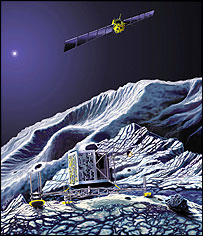One of the devices on board the lander that will descend from the Rosetta spacecraft and land on a comet in the next decade is designed to analyze the composition of the materials that will be dug up from the comet's soil
Avi Blizovsky

One of the interesting devices on board the Rosetta spacecraft is designed to "smell" the comet and analyze its components, after heating samples of it in a miniature oven. Rosetta was launched on March 2, 3 on an Ariane 2004 rocket originating in French Guiana, and is supposed to reach Comet Churyumov-Garsimenko and land a small lander on its surface in 5.
The European Space Agency's Rosetta spacecraft will be the first spacecraft to land on a comet. After the lander reaches Comet 67P/Churyumov-Gerasimenko, the primary spacecraft will follow the comet for many months as it makes its way toward the Sun.
The accepted hypothesis is that comets are the primitive building blocks of the solar system. This will help us understand whether life on Earth began with the help of 'seeding' from comets.
The instrument known as 'Ptolemy' (Ptolemy), the first example of a new concept of space instruments, was designed to meet the challenge of analyzing components across other bodies in the solar system. The device weighs 4.5 kg and is the size of a shoebox. It was created in collaboration with Rathford-Appleton Laboratories from the UK and the UK's Open University.
The analysis of these samples from the surface of the comet will make it possible to know with certainty what the cometary nuclei are composed of, and will provide valuable information about these primitive objects.
After the lander lands on the comet, Ptolemy will collect the materials above the comet's surface, most likely a frozen mixture of ice, dust and gases, using the sampling, drilling and distribution system (SD2) provided by Technospazio Milano from Italy. SD2 will excavate small cores of ice and dust from depths of up to 250 millimeters.
The collected samples will be transferred to one of the four tiny ovens intended for Ptolemy, located inside a round and rotating carousel. The carousel, made in Germany, includes 32 such tiny ovens with the others being used by other Rosetta devices.
Of the four ovens, three are intended for solid samples to be collected by SD2 while the fourth will be used to collect volatiles from the comet's near-surface atmosphere.
By heating the solid materials to 800 degrees, the furnace will turn them into gases that will pass through a pipe into Ptolemy. The gas will be separated into its chemical components using a gas chromatograph.
Ptolemy will be able to determine which chemicals are in the sample of the comet and will help build a detailed picture that will describe what the comet is made of.
It will do this using the world's smallest ion trap mass spectrometer. It's a small, power-efficient device built with the latest miniaturization technology. This instrument will decipher what gases are present in any specific sample and will also measure the ratio of stable isotopes.
